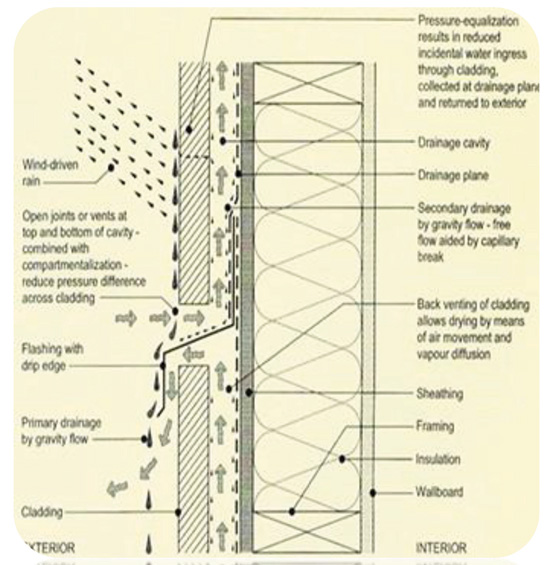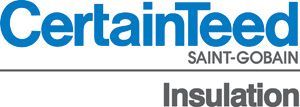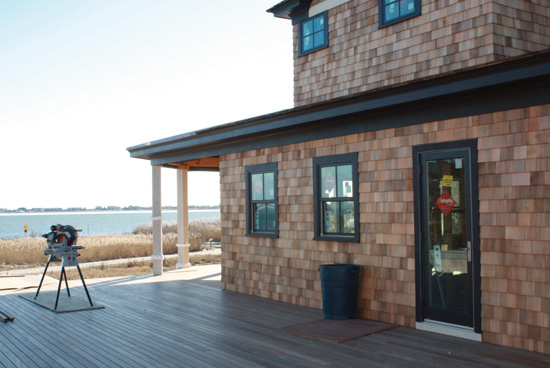The Science Behind Building Envelope Design in Framed Wall Assemblies
Wall Assembly Options
While framed walls have things like studs and sheathing in common, there are many variations and options on how to insulate, protect, and finish those walls. In all cases the different components of the wall must be integrated into the rest of the building envelope so a complete and continuous system of enclosure is achieved. Nonetheless, there are four common types of assemblies described as follows in terms of how they incorporate the building science and design concepts discussed.
Face-Sealed Wall Assemblies
This traditional approach relies on the outermost wall surface material to be sealed to resist weather-related water. The surface may be solid concrete, masonry, solid wood, or others, but the important point is that it is designed to achieve primary water and air tightness at the face of the cladding. That means that joints in the outer surface and interfaces with other wall components must be sealed since the exterior face of the wall is the primary drainage path. Over time, it also means that the wall must be constructed and maintained in nearly perfect condition to control rain water intrusion. In reality, most are good at shedding water on the face, but some water can penetrate the wall where it needs to be released as water vapor or condensed liquid. Weep holes in masonry construction, for example, are designed for this purpose. Generally, this type of wall construction is only recommended in low-risk situations since face seals can fail and allow more water or moisture into the wall than may have been anticipated. (i.e. wetting will exceed drying). Buildings with deep roof overhangs located in dry climates are good candidates for this type of system.
Rainscreen Assemblies
This type of system is gaining in popularity in part because it allows for great flexibility and redundancy of protection. Essentially, a rainscreen anticipates and plans for weather penetration. The outer surface (cladding) can be virtually any material but it is intentionally not sealed the way a face-sealed assembly would be. Instead, a water and air barrier is placed over the substrate to create a continuous drainage plane. The cladding is then held away from this drainage plane to create an intentional air space that allows moisture or water to drain away harmlessly. The air space also promotes ventilation and drying of the wall assembly. Insulation is contained behind the drainage plane either in the stud cavities or in a continuous layer or both. In practice, there are two types of systems—simple rainscreens and pressure-equalized rainscreens (PERs). Simple systems allow differences in air pressure due to wind or other conditions to be absorbed by the cladding or support system and transferred to the building. PERs allow rapid air pressure equalization between the outside of the cladding and the drainage space behind by using generous ventilation spaces, compartmentalization, or even porous cladding. Both types allow the cladding to take the brunt of weathering conditions and protect the air and water barrier behind it to create a fairly watertight and airtight condition. Hence, they are appropriate for use in virtually any climate zone or weather condition if properly designed and detailed.


Images courtesy of CertainTeed Insulation
Rainscreen wall assemblies (top) intentionally allow more air and water to penetrate, drain, and dry between the cladding and the air/water barrier systems (bottom).
Concealed Barrier Assemblies
Wall systems that rely on a mixed approach to cladding and protection can be referred to as a concealed barrier assembly. In this case the cladding or siding is not face sealed, meaning that it anticipates some water or moisture penetration. However, it is not a full rainscreen since the amount allowed or anticipated is limited and expected to be minimal. The cladding is expected to shed or deflect most of the water and wind, but a secondary barrier, concealed behind the cladding, acts as back-up protection. As such it creates a minimally vented drainage plane that is intended to allow any moisture to flow down to flashing or other appropriate outlets. Most residential framed walls use this type of system with an air and water barrier behind siding of some sort. It can also be used behind other types of cladding or finishes. It is most appropriate for areas that receive moderate levels of wind and rain.
Stucco and EIFS Systems
There are different types of finished wall systems that use a layered finish system over a an exterior substrate on a framed wall (with or without stud cavity insulation). Traditional stucco-based wall assemblies rely on using a drainage plane and air and water barrier between the stucco and the substrate as a safeguard against breaks or failures in the cementitious outer surface. Exterior insulation and finish systems (EIFS) use an outer layer of rigid insulation over the substrate which is good from a continuous insulation standpoint but may or may not be good from a moisture standpoint depending on the details of the system. The insulation needs to allow for drainage behind it to avoid moisture issues in the wall which might result from improper drying of the wall. Regardless of the system used, careful attention to detail is required since different systems yield different performance related to thermal, moisture, and air movement. Proper treatment of joints, junctions, thickness changes, etc. include appropriate flashing and an understanding of the capabilities of a manufacturer's system. Manufacturer's information should be consulted for the most appropriate climate and weather conditions for a particular system.
Specifying Framed Exterior Wall Products
With an understanding of the building science and a decision made on the type of wall system to use for a particular building, specifying products for framed exterior walls needs to include all of the component parts and pieces of that assembly. The framing will be a matter of preference or code requirements for steel or wood appropriately sized for the application. The exterior surface cladding will be selected based on multiple design factors and needs to carry the appropriate ability to seal or be penetrated depending on the wall type. The remaining materials and products in the assembly will be very important for proper performance.
Exterior substrates or wall sheathing can be selected from a wide variety of choices including solid or processed wood panels, cement board, foam insulation, or exterior gypsum board. Of these, exterior gypsum board with fully embedded glass mat and water-resistant core and faces have become the most preferred choice for many applications. It provides very good water resistance, mold and mildew resistance, fire resistance, superior strength compared to other options, weathers very well during construction, and is easy to handle and install. Next, the air and water barriers required by building codes are usually placed directly over the selected substrate. They can take several forms including integral to the sheathing (with seams sealed/taped), sheet or roll products, or spray on type of materials. The most appropriate choice will depend on the type of wall assembly being used.
Vapor barriers as mandated by energy codes and critical for good wall performance can vary by product type and perm rate. Some are attached directly to batt insulation products and allow varying degrees of protection in a fairly static state. Some advanced products have become available, however, that change their perm rating as the relative humidity changes. This means that they restrict moisture from penetrating the barrier in low humidity conditions, but if the humidity level rises within the wall, it allows the moisture to pass through and drain away harmlessly. This type of membrane is also available as roll material, and although it looks like a common PVC vapor barrier, it is in fact a very different material with superior capabilities.


Images courtesy of CertainTeed Insulation
The latest generation of vapor barriers is made to prevent moisture from penetrating in cold and dry periods, but allow it to escape in wet and humid conditions.
Insulation needs to be specified based on the overall thermal performance that is desired for a given wall. Different insulation products such as batt-type, blown-in, or spray foam all have different thermal and physical properties so selecting the most appropriate one will depend on the particulars of the building and wall design. Some provide air and moisture sealing as part of their single product make-up such as spray foam insulation. Others, like batt type insulation can be specified with or without an integral vapor barrier.
Conclusion
Framed exterior walls are likely to continue being used in design and construction projects for years to come. As long as we are using them in our buildings, we might as well design them to perform to their highest potential. This is best done by using the principles of building science to understand the forces and conditions that directly influence the movement of heat, air, water, and moisture. With this knowledge, architects can design and specify exterior walls that will perform consistently well for the entire life of the building and avoid problems associated with poor wall design.
Endnote
 |
With more than 100 years of experience, CertainTeed Insulation is the only insulation manufacturer with a truly comprehensive offering to help you achieve optimal comfort, with fiberglass Sustainable Insulation®, blowing wool, spray polyurethane foam, smart vapor retarder and air barriers, and mold protection. www.certainteed.com/insulation |









